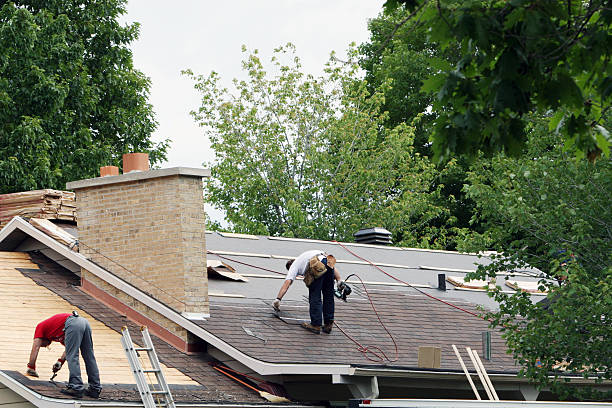Roof installation is one of the most crucial steps in any building project, whether it’s a new construction or a roof replacement. A well-installed roof protects the structure, enhances curb appeal, and ensures energy efficiency. In this guide, we’ll cover everything from the types of roofing materials to the installation process and post-installation care.
Importance of a Well-Installed Roof
A quality roof installation in Linden NJ does more than keep your home dry—it helps maintain structural integrity, improves energy efficiency, and increases property value. A properly installed roof ensures the longevity of your home and saves you money on repairs and energy bills in the long run.
Types of Roofing Materials
Choosing the right roofing material is key to a successful installation. Common types include:
- Asphalt Shingles: Cost-effective, easy to install, and available in many colors.
- Metal Roofing: Durable, energy-efficient, and low-maintenance, but often more expensive.
- Tile Roofing: Adds elegance, especially to Mediterranean-style homes, but is heavier and requires a strong support structure.
- Slate Roofing: Extremely durable and weather-resistant, though it comes with a high upfront cost.
- Wood Shingles or Shakes: Natural look, but requires more maintenance and isn’t suitable for fire-prone areas.
Factors to Consider Before Installation
Before starting a roof installation, it’s essential to consider:
- Climate: Choose materials that withstand local weather conditions.
- Budget: Set a realistic budget to balance quality and affordability.
- Roof Slope: Steeper slopes may restrict certain materials.
- Aesthetic Preferences: Roofing material impacts the overall look of your home.
Steps Involved in Roof Installation
A standard roof installation typically follows these steps:
- Planning and Preparation: Choosing materials and obtaining permits.
- Removing Old Roofing (if needed): Removing existing shingles or roofing material.
- Inspecting the Roof Deck: Ensuring the underlying deck is solid and free of damage.
- Installing Underlayment: Adding a protective layer to guard against leaks.
- Installing Flashing: Placing flashing around chimneys, vents, and valleys for waterproofing.
- Laying Roofing Material: Securing shingles, tiles, or metal sheets.
- Cleaning Up and Final Inspection: Ensuring a spotless area and checking for any potential issues.
Professional Roof Installation vs. DIY
While DIY roof installation might be appealing for the cost savings, it can also be risky and challenging without proper experience. Professional installers bring expertise and have access to quality materials and safety equipment. Hiring a professional ensures that the job is done right the first time, with warranties typically included.
Roof Installation Costs and Budgeting
Roof installation costs vary widely based on material, roof size, and complexity. Here’s a general breakdown:
- Asphalt Shingles: $5,000–$8,000 for an average-sized roof.
- Metal Roofing: $8,000–$15,000.
- Tile Roofing: $10,000–$18,000.
- Slate Roofing: $20,000+ due to its high durability and premium quality.
Budgeting for a roof installation includes not only materials but also labor, permits, and potential additional expenses like structural reinforcement.
Common Roof Installation Mistakes to Avoid
Roof installation requires attention to detail, as even minor errors can lead to significant problems. Common mistakes include:
- Incorrect Nail Placement: Can cause leaks and reduced shingle durability.
- Poor Flashing Installation: Leads to water intrusion around chimneys and valleys.
- Inadequate Ventilation: Causes moisture buildup and premature aging of the roof.
- Skipping the Underlayment: Leads to water damage over time.
Post-Installation Maintenance Tips
Once your roof is installed, proper maintenance will extend its lifespan and help you catch issues early. Maintenance tips include:
- Regular Inspections: Look for damaged or missing shingles.
- Clean the Gutters: Prevent water backup and leaks by removing debris.
- Trim Overhanging Branches: Minimize roof damage from falling limbs.
- Check for Moss and Algae: Prevent growth that can cause moisture retention.
Signs You May Need a Roof Replacement
Even with a high-quality installation, roofs eventually age and need replacement. Signs to look for include:
- Shingle Curling or Buckling
- Frequent Leaks and Repairs
- Granules in the Gutters
- Sagging Roof Deck
FAQs
Q1: How long does a roof installation take?
The timeline depends on roof size, type, and weather conditions. Most installations take 1–3 days.
Q2: Can roof installation be done during any season?
Roof installation can be done year-round, though some prefer spring or fall to avoid extreme temperatures. Summer and winter installations require special precautions for material handling.
Q3: Is a new roof installation noisy?
Yes, roof installation involves loud tools and material handling. It’s advisable to inform neighbors and make arrangements if noise-sensitive.
Q4: How long does a new roof typically last?
Roof lifespan varies by material: asphalt shingles last 20–30 years, while metal, tile, and slate roofs can last 50 years or more with proper maintenance.
Q5: Do I need a building permit for a roof installation?
Most regions require a permit for roof replacement, especially if structural changes are involved. Check with your local authority.
Conclusion
A successful roof installation combines quality materials, skilled workmanship, and proactive maintenance. Whether you’re building a new home or replacing an old roof, understanding the process and making informed decisions will help ensure a roof that protects and enhances your home for decades.
